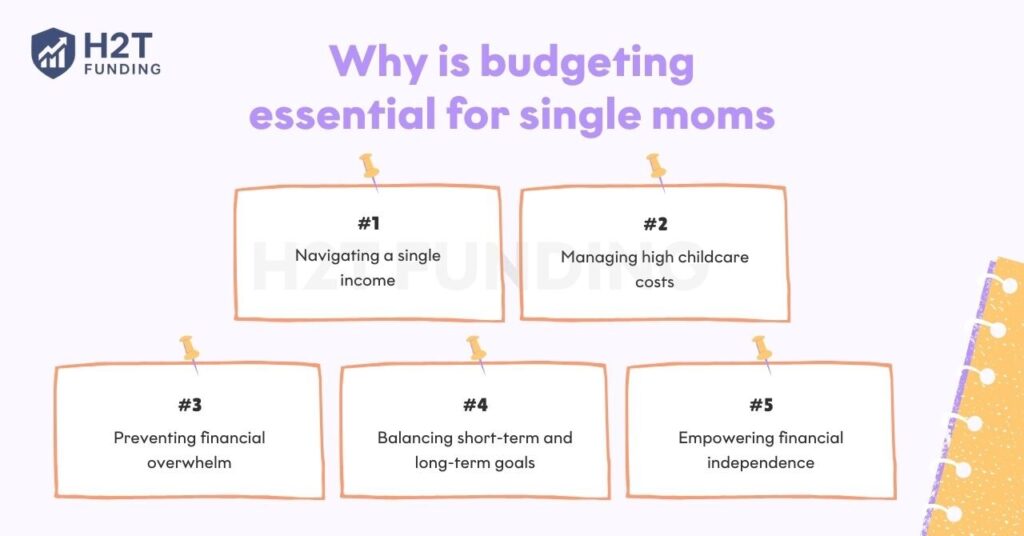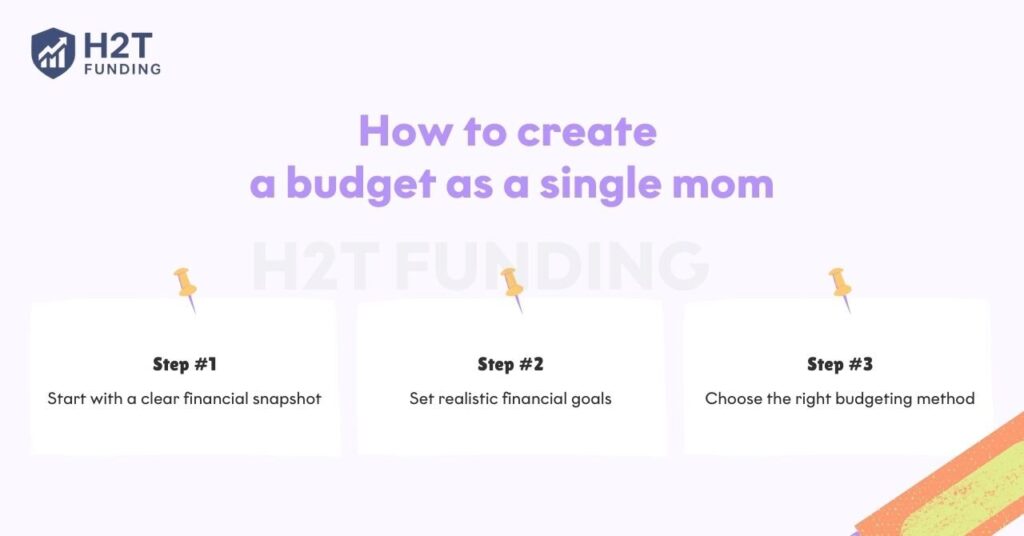Budgeting for single moms isn’t just about cutting costs; it’s about creating financial stability, even in the face of overwhelming responsibilities. With only one income and countless expenses, such as childcare, groceries, rent, and unexpected emergencies, single mothers often have to make every dollar count.
But here’s the good news: Smart budgeting doesn’t require a finance degree.
“A budget is telling your money where to go instead of wondering where it went,” said Dave Ramsey, personal finance expert.
Drawing from expert insights like Dave Ramsey’s and real-world stories, H2T Funding shares 9+ practical, proven tips for budgeting. These budgeting ideas also serve as money-saving tips for single moms to stretch their resources further. Whether you’re aiming to save, reduce debt, or simply get through the month with less stress, these tips will help you take back control.
Key takeaways:
- Budgeting single mom helps manage a limited income and ensures essential expenses are covered while preparing for the future.
- Budgeting for a single person should start by writing down all income and expenses, setting realistic goals, and choosing budgeting methods such as the 50/30/20 rule or zero-based budgeting.
- Families can improve financial security by prioritizing essentials, saving creatively, cutting nonessentials, building a small emergency fund, and exploring extra income opportunities.
- Regular reviews, access to financial assistance programs, and teaching children financial literacy all contribute to long-term stability.
- Tools like YNAB, EveryDollar, and customizable templates make money management easier and more organized for busy parents.
1. Why is budgeting essential for single moms?
Budgeting for single moms is a critical step toward financial stability, offering clarity and control in a world of unique financial demands, and single mom income is often limited, making it even more important to track and optimize every dollar.
Here are the key reasons why creating a budget is vital for single mothers, followed by a practical example to illustrate its impact.

- Navigating a single income: Single mom budgeting often relies on one income to cover all household expenses, unlike dual-income households. This makes managing finances challenging, as there’s no secondary income to fall back on. Essential costs can quickly consume monthly earnings, leaving little room for savings or unexpected expenses.
- Managing high childcare costs: Childcare is often a major burden for single mothers, with daycare or after-school programs costing hundreds of dollars monthly. A well-planned budget helps prioritize these expenses while ensuring other essentials of financial planning for single mothers are met.
- Preventing financial overwhelm: Without a clear plan, unexpected expenses like medical bills or car repairs can lead to debt or financial stress, often pushing single parents to seek financial assistance from community programs. Budgeting provides a roadmap to anticipate and prepare for such costs, reducing anxiety and fostering confidence.
- Balancing short-term and long-term goals: Single moms must juggle immediate needs, like paying utility bills, with future aspirations, such as saving for a child’s education or retirement. Effective budgeting tips for single moms include allocating funds for both, ensuring stability now and security later. This is a vital part of financial planning for single parents who must prepare for today and tomorrow simultaneously.
- Empowering financial independence: A budget empowers single moms to take charge of their finances, make informed decisions, and avoid reliance on credit or loans. It creates a sense of ownership over their financial future, which is especially crucial for those newly independent after a separation or divorce.
This reminds me of a friend of mine, we’ll call her Anna. She was earning around $2,800 a month and felt like she was constantly on a financial treadmill, especially with childcare and rent eating up the majority of her income. When she finally sat down and mapped out her spending, she was shocked to see nearly $200 going to small, almost unnoticeable purchases like daily coffees and takeout.
By redirecting just half of that into an emergency fund and the other half toward a small college fund for her daughter, the change was more emotional than financial. It was the first time in a long time she felt she wasn’t just surviving, but actively building a future.
Read more:
2. How to create a budget as a single mom
Budgeting for single moms is a straightforward way to take control of money, ensuring daily needs are met while planning for the future. The steps below are tailored to handle challenges like limited income and childcare costs, making budgeting simple and practical.
- Step 1: Start with a clear financial snapshot
- Step 2: Set realistic financial goals
- Step 3: Choose the right budgeting method
By following these steps, single moms can create a budget that is both realistic and sustainable. Let’s break them down in detail, starting with Step 1.

2.1. Step 1: Start with a clear financial snapshot
Write down all your income, like your paycheck or child support, to know what you have. List all expenses, such as rent, childcare, groceries, and any debts like credit card payments.
Tip: Use a free app or a basic spreadsheet to track where your money goes. For even more precision, try a single mom budget calculator to see exactly how much you can allocate to each expense category.
2.2. Step 2: Set realistic financial goals
Setting financial goals is essential, but they need to be realistic and manageable, especially for single moms who are juggling multiple responsibilities.
Start with short-term goals that create immediate relief, like paying utility bills on time or clearing a $500 credit card balance, simple but effective steps in budgeting single-mother households. Then look ahead to long-term goals, such as saving $2,000 for your child’s future education or building an emergency fund.
One of the biggest hurdles we all face is feeling so overwhelmed by big goals that we do nothing at all. I remember a friend, Sophia, who felt overwhelmed by debt and couldn’t imagine saving anything. So, she decided to break it down into small steps:
- First, she focused on clearing a $300 electricity bill within two months.
- Then, she set a goal to save just $50 a month for her son’s education.
- Within a year, she had paid off all her utility debts and saved over $700 in a dedicated education fund, something she once thought was impossible.
Sophia checked in with her goals monthly and made small adjustments when her income changed. That flexibility kept her motivated, even when unexpected expenses came up.
The key is to prioritize what’s urgent, then build momentum with small wins. Big financial changes often start with tiny, consistent steps, like $50 a month.
By reviewing your goals regularly, you stay connected to your progress and stay motivated without feeling overwhelmed.
2.3. Step 3: Choose the right budgeting method
Exploring different budgeting methods and finding one that matches your lifestyle is key to managing your money effectively, especially when you’re navigating finances on your own. Two popular methods to consider are the 50/30/20 rule and zero-based budgeting.
The 50/30/20 rule divides your income into simple percentages:
- 50% for needs like rent, groceries, or childcare
- 30% for wants like eating out or streaming services
- 20% for savings or paying off debt
It’s an easy starting point if you prefer a flexible structure.
On the other hand, zero-based budgeting assigns every single dollar a specific job. For example, if your monthly income is $3,000, you might allocate $1,200 for rent, $600 for childcare, $300 for groceries, and so on, until your budget “zeroes out.” This method requires more effort but offers detailed control.
Personally, I tried both methods during my first year living independently. While the 50/30/20 rule gave me a sense of balance, I eventually switched to zero-based budgeting because it helped me track every expense and build savings faster. A friend of mine, also single, is stuck with 50/30/20 and loves the simplicity.
There’s no one-size-fits-all approach. Test both methods for at least a month each to determine which one best fits your goals, habits, and income. What matters most is consistency and finding a system you’ll stick with.
Find out more:
3. 10 effective tips for budgeting for single moms
As a single mom, juggling bills, childcare, and daily responsibilities can feel like an uphill battle, but budgeting for single moms doesn’t have to be. Imagine the relief of knowing exactly where your money goes, like Sarah, who went from sleepless nights worrying about rent to confidently saving for her daughter’s future.
In this section, you’ll discover practical ways to:
- Stay consistent by adjusting your budget and mindset.
- Take control of essential vs. non-essential expenses.
- Find creative strategies to save and increase income.
- Manage debt and build financial security step by step.
These tips will help you simplify money management and make budgeting feel less overwhelming. With the right approach, financial security becomes an achievable goal for every single mom.
These practical budget tips for single moms are crafted to stretch your income, ease financial stress, and pave the way for a secure tomorrow. Each tip fits the hectic life of a single parent, offering simple steps to achieve financial stability.
3.1. Prioritize essential expenses
Start your budget by covering the most critical needs: housing, food, utilities, and childcare. These four walls keep your family safe and stable. Pay for rent or mortgage, groceries, electricity, and daycare before spending on anything else. This ensures your household runs smoothly, even on a tight budget.
3.2. Find creative ways to save on essentials
Look for ways to lower costs on necessities without sacrificing quality. Use coupons, shop at discount grocery stores, or join utility assistance programs to save on bills. For childcare, explore subsidies or co-op daycare options.
Buying in bulk or using loyalty programs can also reduce grocery expenses significantly. Setting a clear single mom grocery budget can further help you avoid overspending at the supermarket.
May you want to know: How to save money on groceries with 13 budget-saving hacks
3.3. Cut non-essential expenses
Review your spending to find areas to trim, focusing on nonessentials like dining out or streaming subscriptions. Switch to affordable alternatives, such as cooking meals at home or enjoying free resources at community events like library storytime. For example, swapping takeout for home-cooked dinners saved Lisa $100 monthly, which she redirected to savings.
3.4. Build a small emergency fund
Setting aside $500 to $1,000 in an emergency fund can make a huge difference when unexpected expenses arise, such as car repairs, medical bills, or even a sudden job loss. Don’t feel pressured to save it all at once. Starting with just $10 a month is enough to begin building a financial safety net.
I saw this firsthand when a close friend lost their job unexpectedly last year. Thanks to an $800 emergency fund they had built up gradually, they were able to cover rent and basic expenses for nearly a month until they found new employment. Without that cushion, they would have had to rely on high-interest credit cards or borrow from others.
It’s best to keep this money in a separate savings account to avoid accidentally spending it on day-to-day expenses. Separating the funds helps maintain discipline and ensures the money is ready when truly needed.
Having even a small emergency fund reduces your dependence on debt and gives you peace of mind. Starting small is still progress, and every dollar saved brings you closer to financial stability.
3.5. Boost your income where possible
Increase your income with flexible side hustles that fit a single mom’s schedule. Try online tutoring, selling crafts on Etsy, or part-time retail work during evenings. For instance, Maria earned $200 monthly by tutoring online, adding extra funds for childcare costs. Explore options that align with your skills and time.
Continue reading on this topic: How to negotiate salary like a pro
3.6. Tackle debt strategically
Focus on paying off high-interest debts, like credit cards, to free up money faster. Consider debt consolidation to combine payments into one lower-rate loan, or negotiate with creditors for better terms. Paying off a $1,000 credit card with a 20% interest rate can save hundreds annually in interest.
3.7. Adjust your budget regularly
Your budget shouldn’t be static. Reviewing it monthly allows you to adjust for changes like a pay raise, new subscriptions, or increased childcare costs. Life isn’t predictable; being flexible helps you stay on track when surprise expenses hit, such as school fee hikes or medical bills.
Life changes, and your budget needs to change with it. This is a lesson my own sister learned the hard way. She got a raise and naturally loosened the reins on her spending, but didn’t account for the small, creeping increases in her rent and daycare fees.
It took a few months, but she eventually found herself dipping into her emergency fund just to cover bills. A quick monthly check-in could have caught the issue long before it became a source of stress.
To make things easier, consider using budgeting tools like YNAB (You Need a Budget) or EveryDollar, which can help track changes automatically and send reminders when something looks off.
By checking in with your budget regularly, you stay in control, not just of your money, but your peace of mind. Small adjustments each month can prevent bigger problems down the road.
3.8. Leverage single-mom resources
Take advantage of support programs designed for single parents. Apply for government assistance like SNAP for food or Head Start for free preschool. Local nonprofits may offer childcare subsidies or utility bill help. These resources can ease financial pressure and stretch your budget further.
3.9. Communicate financial realities with your kids
Explain money basics to your children in simple, age-appropriate ways. For example, involve them in choosing between a toy and a family outing to teach trade-offs. This builds their understanding and encourages teamwork.
Early exposure to budgeting also promotes financial literacy for single mothers and their children, helping future generations make wiser money choices. A child who learns budgeting early may even suggest cost-saving ideas.
3.10. Invest in self-care to stay focused
Maintaining mental and emotional health helps you make clear financial decisions. Practice low-cost self-care, like meditation, a walk in the park, or attending free community yoga classes. Staying balanced keeps you motivated to stick to your budget plans for single moms, ensuring long-term success.
4. Best tools and apps for single moms’ budgeting
Budgeting as a single mom isn’t just about numbers; it’s about making your money work for your family’s real, everyday needs. Fortunately, there are tools specifically designed to help simplify finances, save time, and reduce stress for busy parents. The right app or template can transform budgeting from overwhelming to empowering.
As someone who helped my cousin, a single mom of two, get back on track after a financial rough patch, I’ve seen firsthand how the right tools can make a difference. She went from feeling lost to confidently managing her income, school fees, and emergency savings, all thanks to the apps and templates listed below.
4.1. Top budget apps for single moms
Choosing the best budget app for single moms can make tracking expenses quick and effective. These apps offer features like goal-setting and bill reminders, tailored to the unique needs of single-parent households. Below are top picks that simplify how to budget as a single mom:
- YNAB (You Need A Budget): Based on zero-based budgeting, YNAB helps assign every dollar a job, perfect for prioritizing rent, groceries, and childcare. The goal-setting feature helped my cousin save $1,000 in just a few months for unexpected car repairs.
- Price: $14.99/month or $99/year
- Free 34-day trial
- Syncs with bank accounts for real-time updates
- EveryDollar: Offers an intuitive interface with customizable categories, making it easy to track single-parent expenses like school fees or extracurricular activities. My cousin started with the free version and upgraded later when she wanted automatic syncing.
- Free for manual entry
- Premium version: $79.99/year
- Quick setup for a clear monthly overview
Pro tip: Try both during their free trial periods and see which interface feels more natural. A tool you enjoy using is one you’ll actually stick with.
4.2. Single mom budget template
A single mom budget template offers a clear, downloadable way to plan monthly finances. To customize these templates, add specific categories like childcare or child support, and base the budget on your lowest monthly income, such as $2,500, to stay safe.
Update monthly to reflect changes, like a $75 increase in daycare costs, ensuring the budget remains practical, and look for discounts that can lighten the financial load. You can also download a monthly budget for a single mom worksheet to track your expenses in a more visual and organized way.
5. FAQs
To create a budget for a single mom, track all income (salary, child support) and expenses (rent, childcare). Prioritize essentials like housing and food, use apps like Mint for tracking, and review monthly to adjust for changes.
A good budget for a single mom is the 50/30/20 rule: 50% for needs (rent, childcare), 30% for wants (entertainment), and 20% for savings or debt. Adjust to 60/20/20 if childcare costs are high.
Manage finances by budgeting carefully, cutting non-essential costs like dining out, boosting income with side hustles, and using resources like childcare subsidies to ease financial strain.
Survive financially by building a $500-$1,000 emergency fund, paying off high-interest debt first, and tapping community support like SNAP or local nonprofits for food and bill assistance.
Top budget apps for single moms include YNAB for zero-based budgeting, Mint for free expense tracking and bill reminders, and PocketGuard for identifying savings by limiting overspending.
To survive financially as a single mom, the key is creating a clear budget, cutting unnecessary expenses, and seeking support programs such as childcare assistance or housing aid. Building an emergency fund and exploring flexible income sources, like side hustles, also help stabilize finances while balancing family responsibilities.
The 70 10 10 10 rule allocates income into four parts: 70% for living expenses, 10% for savings, 10% for debt repayment, and 10% for giving or investing. This simple framework helps maintain control over money while ensuring that both present needs and long-term goals are covered.
Single mothers need financial stability, reliable childcare, and emotional support to balance work and parenting. Access to community resources, affordable healthcare, and opportunities for career growth are also crucial in helping them build a sustainable and secure future for themselves and their children.
A single mom should aim to save at least three to six months’ worth of living expenses in an emergency fund. This cushion provides security against unexpected events such as job loss, medical bills, or childcare emergencies, helping reduce financial stress and maintain stability.
6. Conclusion
Budgeting for single moms is a powerful tool for achieving financial independence and reducing stress. It helps manage limited income, prioritize essentials like childcare, and plan for future goals, bringing peace of mind. Start small with simple steps, like tracking expenses, and stay consistent to build confidence. Seek support from community resources or financial apps when needed.
Let’s take action today: download a single mom budget template, try apps like YNAB, or join a single-mom financial community for shared tips. For more budget ideas for single moms, explore additional articles in the Strategies section and Budgeting Strategies at H2T Funding to deepen your financial knowledge.\





